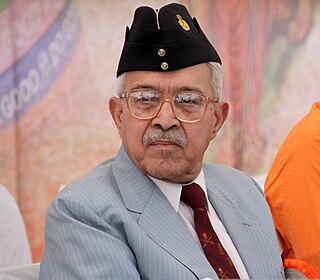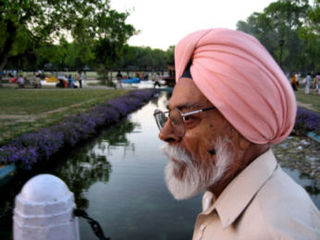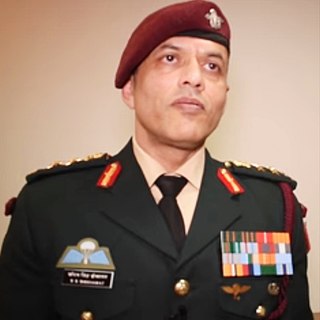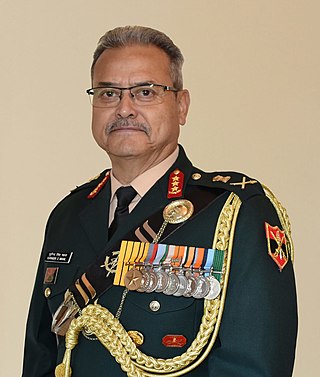
Captain Bana SinghPVC is an Indian soldier and a recipient of the nation's highest gallantry award, the Param Vir Chakra. As a Naib Subedar in the Indian Army, he led the team that wrested control of the highest peak on the Siachen Glacier in Kashmir from Pakistani forces as part of Operation Rajiv. Following his success, India renamed the peak to Bana Post in his honour.

Lieutenant General Mohammad Ahmed Zaki is a former general officer of the Indian Army.

General Nirmal Chander Vij PVSM, UYSM, AVSM was the 21st Chief of Army Staff of the Indian Army. He held the office from 1 Jan 2003 to 31 Jan 2005.

Lieutenant General Joginder Singh Dhillon was an Indian military officer and the first recipient from the military to be awarded India's third highest civilian award, the Padma Bhushan, for his role in the Indo-Pakistani War of 1965, where he was the general officer commanding the XI corps.

Lieutenant Colonel Jaswant Singh Marwah is an Indian former soldier, journalist and author, and the father of General Joginder Jaswant Singh, the first Sikh Chief of Army Staff of the Indian Army. He was a former Special Duty Officer in the Archaeological Survey of India, and served in the Indian Army's Electrical Mechanical Engineering branch from 1943 to 1973. A veteran of the Second World War, he received an emergency commission in the Royal Indian Army Service Corps on 27 June 1943. He was awarded the Nehru Award in 1981 and 1984, by the Vice President of India and the President of India respectively. In 1987 he was awarded the Journalism Award by the Indian Ministry of Communications.

General Deepak Kapoor PVSM, AVSM, SM, VSM, ADC served as the 22nd Chief of the Army Staff of the Indian Army, appointed on 30 September 2007 and Chairman of the Chiefs of Staff Committee appointed on 31 August 2009.

General Shankar Roychowdhury is a former Chief of Army Staff of the Indian Army, and a former member of the Indian Parliament.

Brigadier Saurabh Singh Shekhawat, KC, SC, SM, VSM is an Indian Army officer of the 21 Para (SF) and an avid mountaineer. He is one of Indian Army's most decorated officers, with one war-time gallantry award and two peace-time gallantry awards to his name.

Colonel Vasanth Venugopal, AC was an Indian Army officer. He was the commanding officer of the 9th battalion, Maratha Light Infantry. On 31 July 2007, he was Attained veergathi in action while preventing heavily armed infiltrators from crossing the India-Pakistan border at Uri, Jammu and Kashmir. As a result he was posthumously awarded the Ashoka Chakra, India's highest military decoration for peacetime gallantry.

General Bikram Singh, PVSM, UYSM, AVSM, SM, VSM, ADC is a retired Indian army officer who served as the 24th Chief of Army Staff (COAS) of the Indian Army. Previously the General Officer Commanding-in-Chief of the army's Eastern Command, he succeeded General V. K. Singh as COAS on May 31, 2012. He retired on 31 July 2014. He is the second Sikh to be COAS, the first having been General J. J. Singh. He was also the Chairman of the Chiefs of Staff Committee (CoSC) of the Indian armed forces.

Lieutenant Navdeep Singh, AC was a Ghatak Platoon Commander of 15 Maratha Light Infantry regiment in the Indian Army.
Lieutenant General Kashmir Singh Katoch, MC was an Indian Army General and military adviser to the Maharaja Hari Singh of Jammu and Kashmir, officiating as the Chief of Staff of the State Forces during the Indo-Pakistani War of 1947. He later served as the Vice Chief of Army Staff of the Indian Army.

General Manoj Mukund Naravane, is a retired Indian Army General who served as the 27th Chief of the Army Staff (COAS), as well as the temporary Chairman of the Chiefs of Staff Committee from 15 December 2021 until his superannuation on 30 April 2022. He took over as COAS from General Bipin Rawat on 31 December 2019 after the latter completed his term. Prior to his appointment as the COAS, the general served as the 40th Vice Chief of Army Staff (VCOAS) of the Indian Army, General Officer Commanding-in-Chief (GOC-in-C) of Eastern Command and General Officer Commanding-in-Chief of Army Training Command.

Lieutenant General Ranbir Singh, PVSM, AVSM & Bar, YSM, SM, ADC is a former General Officer in the Indian Army. He last served as the General Officer-Commanding-in-Chief (GOC-in-C) Northern Command. He assumed office on 1 June 2018 from Lt Gen Devraj Anbu who assumed the office of Vice Chief of the Army Staff. He was the Director General of Military Operations (DGMO) of the Indian Army during the 2016 Indian Line of Control strike & during the 2015 Indian counter-insurgency operation in Myanmar he was Additional Director General of Military Operations (ADGMO). He was considered the face of the operations because he briefed the media after both the strikes.
Major General Anant Singh Pathania MVC, MC was a decorated Indian Army general; the first Indian to receive a Military Cross in the Second World War, he was also the first Indian commanding officer of the Gorkha Rifles. During the Sino-Indian War of 1962, he commanded the 4th Infantry Division during a critical stage of the conflict where his leadership was criticised.

Lieutenant General Alok Singh Kler, PVSM, VSM, ADC is a retired General Officer in the Indian Army who last served as General Officer-Commanding-in-Chief of the South Western Command. He assumed office on 1 September 2019, taking over from Lt Gen Cherish Mathson.

Lieutenant General Raj Shukla, PVSM,YSM, SM, ADC is a retired General Officer of the Indian Army who served as the General Officer Commanding-in-Chief of the Army Training Command. He assumed office on 1 May 2020, succeeding Lt Gen P C Thimayya. He superannuated on 31 March 2022. Presently he is a member of UPSC.

Lieutenant general Manjinder Singh AVSM,YSM, VSM is a serving general officer of the Indian Army. He currently serves as the General Officer Commanding-in-Chief Army Training Command (ARTRAC) Shimla. He previously served as the Deputy Chief of Integrated Defence Staff at HQ IDS.
He is the present Colonel of the Madras Regiment.

Lieutenant General Ajai Singh PVSM, AVSM is a retired Indian Army general. He served as the 16th Commander-in-Chief, Andaman and Nicobar Command (CINCAN). He assumed command from Lieutenant-General Manoj Pande, PVSM, AVSM, VSM on 1 June 2021.

Lieutenant General Surinder Singh Mahal is a retired general officer in the Indian Army who served as the General Officer Commanding-in-Chief of the Army Training Command (ARTRAC). He superannuated on 30 November 2023.




















